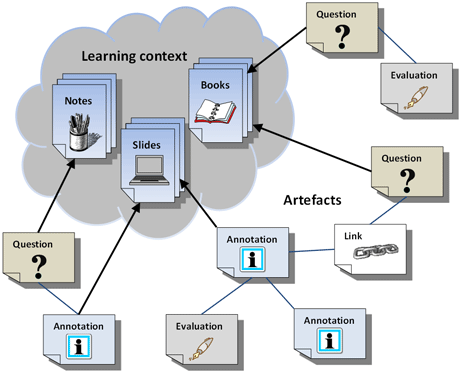by Matthias R. Brust, Adrian Andronache and Steffen Rothkugel
In retrieving information, today's mobile devices are able to connect directly the Internet via UMTS/GSM links, allowing them to consult neighbouring devices by using free-of-charge Bluetooth or Wi-Fi links. Increasing numbers of students are taking advantage of these mobile devices in order to advance in their studies faster and more efficiently. The HyLearn application supports the student in the use of any possible wired or wireless communication link to search for teaching material, and fosters cooperation between students.
HyLearn is a cooperative learning system for mobile devices running on a hybrid wireless network. HyLearn allows students to develop personalized sets of their teaching material (see Figure 1), including annotations, questions and links. HyLearn deploys information to interested nodes through both fixed and mobile networks. Due to the mobility of nodes, an efficient approach to ad hoc self-organization is required. We apply a clustering technique that forms hierarchical structures of an otherwise homogeneous ad hoc network. This multi-hop clustering algorithm is parameterized in terms of cluster size and can therefore adapt to the mobility degree of nodes. Only local information is required to establish and maintain clusters. The algorithm is based on HyLearn's expected communication pattern.

The HyLearn application applies the well-known podcast mechanism to disseminate information. A podcast is a multimedia file distributed over the Internet using the syndication feeds mechanism. The provider - known as a podcaster - creates the content and posts the information on a Web server. The episode is posted as an element of a syndication feed in RSS format, which provides information about the series and its episodes: publishing date, title, description and so on.
The teaching context is a common set of lecture-related information, initially distributed by the lecturer in the form of podcasts. Running on students' devices, the HyLearn application will discover the new podcast in the ad hoc network and enable the students to subscribe to it. This will instantly provide them with the lecture material from the teachers' notebook, without needing to use an Internet connection.
Students can also use HyLearn to augment the teaching material by adding student-created artefacts, thus creating their own episodes of the podcast.
When studying the material later on, students can use questions added by the teacher or their own questions to gain a deeper understanding of the topics covered. They are also encouraged to add annotations to the teaching material, slides, and questions.
Moreover, students may discover additional relationships between some sections of the teaching material, their annotations, and the questions, and can add these as links. While using the application, the subset of available material can be augmented by meeting other students. Students are able to evaluate artefacts with respect to their usefulness, in order to prevent misleading or false supplements to the teaching material from being distributed. Students can use the system during and after lectures, are able to join interest groups by sharing their material, and can help each other in a cooperative and collaborative way, such as in preparing for exams.
Managing the teaching material together with the data added by students is a challenging task. We assume that students at different universities will have different lectures and learning material related to the same topic. Thus, all participating devices can form multiple ad hoc network partitions over time. HyLearn enables students to search foreign networks such as ad hoc networks on other university campuses for podcasts related to their current interest. To achieve this, HyLearn organizes the ad hoc networks into clusters by electing local leaders called clusterheads that maintain uplinks to a backbone server. Only devices with a backbone connection will be elected as clusterheads. HyLearn users can search for podcasts by entering keywords related to the lecture of interest: HyLearn then sends the search query to the local clusterhead, which will forward it to the backbone.
The HyLearn backbone will inject the search query to all registered clusterheads, thus querying devices in different networks and network partitions. When a clusterhead receives a search query, it sends it to neighbouring ad hoc devices, thus performing a local search. The podcast feeds on the network devices that match the keywords of the query will be sent to the backbone via the local clusterhead. The backbone forwards the matching feeds to the requesting device and caches the podcast to satisfy further search queries directly. HyLearn uses a cluster topology in the ad hoc networks in order to minimize the number of uplink devices in a partition. This in turn reduces the number of search queries sent to a network partition as well as the number of redundant results sent to the backbone from a network partition. For this, we developed a k-hop clustering algorithm. The algorithm is shown to be highly adaptive to mobility and works with local 1-hop neighborhood information only, asynchronously and in a fully distributed fashion.
Links:
http://mocca.uni.lu
http://hymn.uni.lu
Please contact:
Steffen Rothkugel
University of Luxembourg
Tel: +352 466644 5259
E-mail: steffen.rothkugel![]() uni.lu
uni.lu










